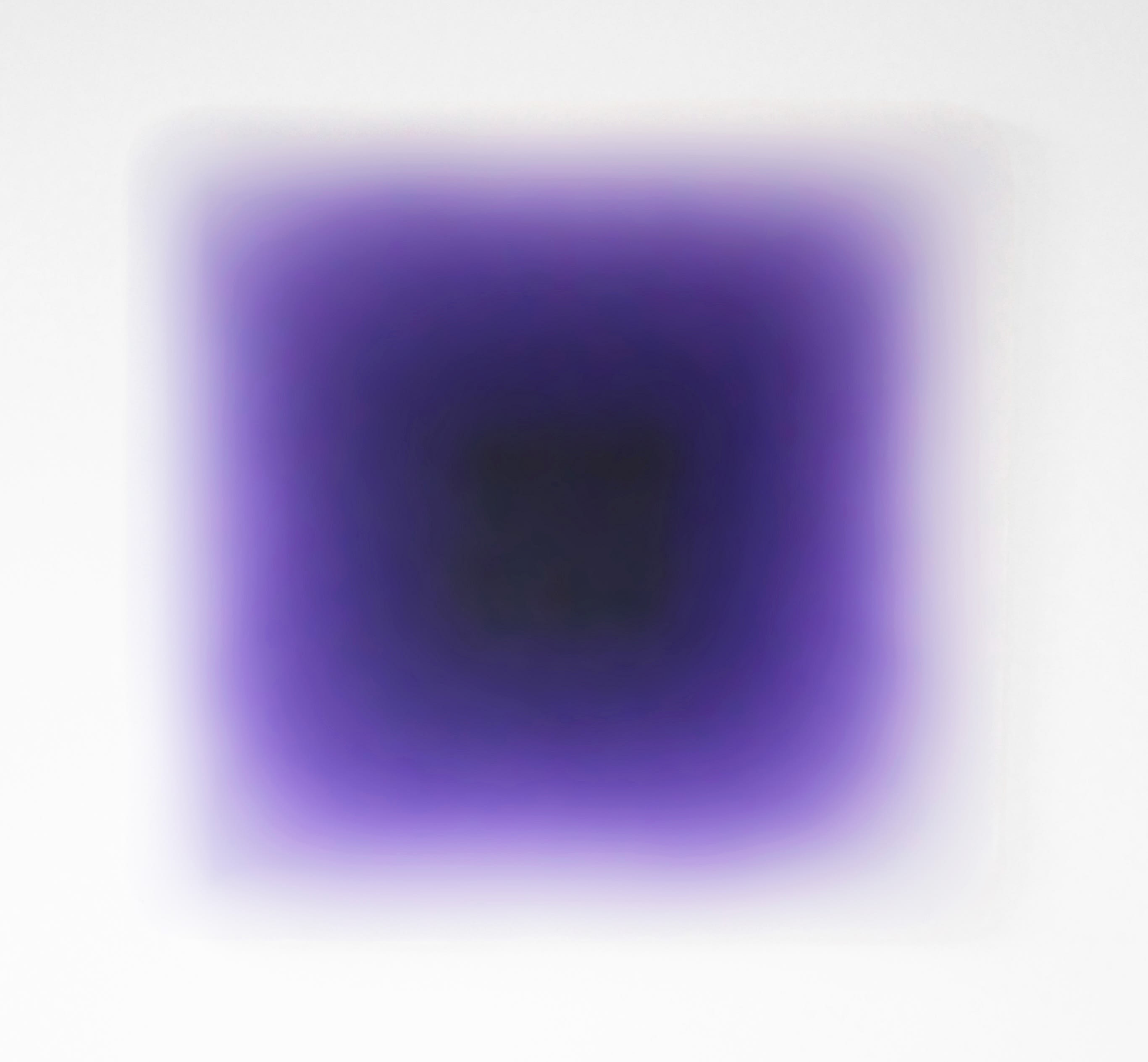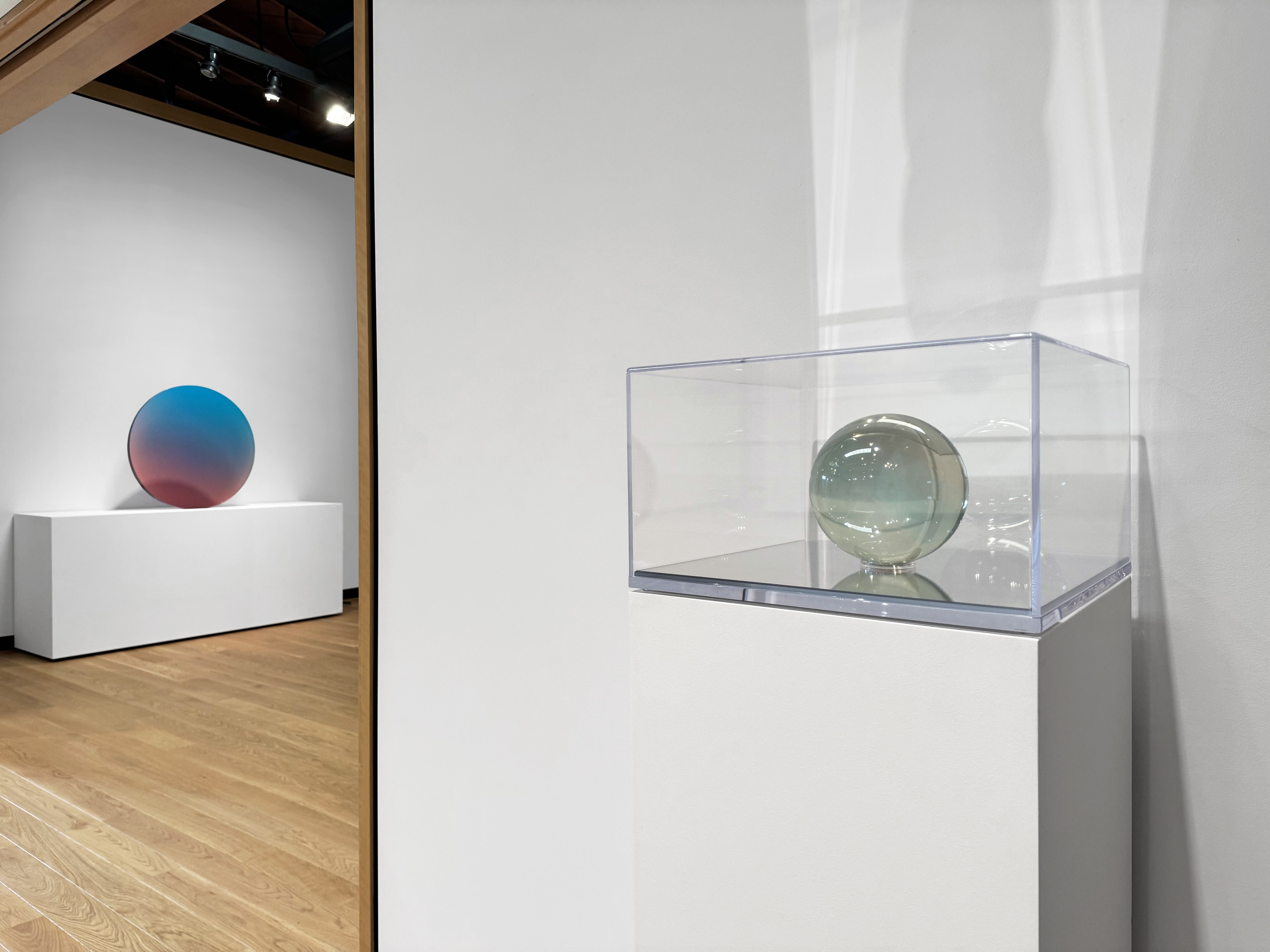It took a trip to Japan last spring to introduce me to California artist James Turrell. Three of Turrell’s immersive works are installed on Naoshima, otherwise known as the “Art Island,” off the coast of Okayama, Japan. All three installations require you to step inside to experience light’s effect on the mind.
Turrell plays with our perception, tricking the brain to see something anew. Imagine a wide staircase leading to an enormous violet rectangle projected onto a white wall. Climb the stairs to view the projection up close. The color is vivid and beautiful. Now trust the docent when she asks you to cross the invisible threshold. What? Impossible. You test one toe, afraid to set your foot down on the other side. But there you are, inside a space that – a moment ago – appeared impenetrable. As you walk into the violet abyss, you discover a room whose size you can’t determine. Turrell calls the 2000 work Open Field. I walked inside it for less than five minutes. It blew my mind.
Now imagine you’ve been plunged inside the darkest space you’ve ever experienced. Backside of the Moon (1999) comes with a warning – do not enter if you’re claustrophobic or scared of the dark. But astonishment awaits you if you do. Trust is once again required in this sensory-deprivation installation. A docent guides you through a maze of twists and turns to gain access to the interior of the structure, where you sit in the dark until your eyes adjust and the room is revealed. More astounding, for the 10 of us who entered together, it happened at precisely the same moment. First, there was nothingness. Then, after several long minutes, a soft glow emerged.
I understood then, in a way I never had before, the mind-bending magnificence of light.
“I’ve always wanted to make a light that looks like the light you see in your dream,” Turrell once said. “I like to use light as a material, but my medium is actually perception. I want you to sense yourself sensing – to see yourself seeing.”
Luminaries of Light, now on display at The Honarkar Foundation through December 14, does just this. Known as “perceptual psychology,” the 25 works by 11 artists alter our experience of light and space and shadow. It’s an exhibition to be experienced instead of viewed because the art is happening in the mind, not on the canvas. As you move around each work, your assessment of it will change with the angles, the light and time of day, and with your own sense of the space.

“Luminaries of Light” is currently on display at The Honarkar Foundation through December 14
“I intended for this exhibition to be immersive and experiential,” said curator Genevieve Williams. “These works are all about the encounter, the exploration and the experience they offer. The more time you spend with them, the more they reward you.”
Williams calls the show the foundation’s most ambitious to date, borrowing many of these historic works from private collectors across the nation and allowing them to be viewed together for the first time.

Robert Irwin’s 3’ x 4’ “Four Fold” (2009-2010)
It’s quite a coup to have one of Turrell’s pieces in our midst. An L.A. artist who studied at Pomona College and UCI, Turrell’s works are now celebrated worldwide. It’s nice to have one here, close to his hometown, also immersive but on a smaller scale. His 2005 Untitled (XIV E) hologram is a visual representation of his psychological theories about how light moves on the viewer. “Light knows when you’re looking at it,” he once said. “One of the tenets in Quaker meditation is that you ‘go inside to greet the light.’ I am interested in this light that’s inside greeting the light that’s outside.”

James Turrell’s “Untitled (XIV E),” 2005
California’s early light and space artists understood something the rest of the art world hadn’t yet discovered – light itself is art. The movement began in the 1960s as this group learned to harvest light’s seductive power and reflect it back to us using industrial materials like resin, acrylic and glass.
The exhibition contains five works by Larry Bell. Since 1963, Bell has explored how light passes through cube-shaped sculptures using a technique known as “vacuum deposition.” By adding thin films to clear glass panels, Bell discovered the glass cubes appeared to float on the light between the floor and the work. As the light reflected, refracted and absorbed into the object, it challenged the viewer’s perception of mass, volume and gravity.
“In my opinion, all artwork is stored energy,” Bell once said. “The art releases its power whenever a viewer becomes a dreamer.”
![]()
Larry Bell’s “Untitled (Corner Lamp),” 1980
Laddie John Dill’s 1971 plate glass, sand and argon light sculpture feels right at home in Laguna Beach. This site-specific installation required the delivery of 6,000 pounds of sand hand-sculpted by Dill into rising and falling dunes that occupy the entire room. Lit from beneath the plate glass, the sculpture reflects and refracts ambient light until the viewer finds the sweet spot, a stretch of green argon that rewards the attentive eye.
“It’s a very immersive and beautiful installation. If you spend time with it, if you move around it, you’ll see different things appear and disappear,” Williams said. “We specifically put it in a darkened room because we have control over the light. The darker, the better.”

Laddie John Dill’s “Untitled,” (1971), sand, argon light and plate glass
Luminaries of Light arrives at just the right time. Fall’s waning daylight casts a unique glow across our town making it the ideal season to experience the golden, softer hues. This season brings longer shadows and slanted rays of sunlight. No surprise it’s the season LPAPA chose for their Annual Plein Air Invitational, and the ideal time for the Laguna Art Museum to stage its Art + Nature show. Sandwiched between the two, it’s as if Laguna’s art institutions are participating in an active visual conversation about light and its impact. That conversation heightens our own awareness of light and makes us better able to appreciate it once we step back outside.

Fred Eversley’s “Untitled (Parabolic Lens),” 2018
“This show is a celebration of California’s unique environment,” Williams said. “Its brilliant natural light, expansive open spaces and coastal beauty have directly inspired these artists. Their work reflects the feeling of endless possibility that California has always symbolized.”

Peter Alexander’s “Purple Puff,” 2014
Laguna Beach gallerist Peter Blake – the world’s longest-running dealer in the California Light & Space movement – said, “In the over 30 years I’ve done this, I have never tired of Light and Space. I still find moments in it that are just amazing.”
Blake recounted Peter Alexander’s story of becoming an artist: “He talked about fixing a surfboard. He put some resin in a paper cup and, when the resin came out of the cup, he was intrigued by it. At the time, he was an architect. But he became an artist because of that moment.”

Peter Alexander’s “Untitled,” (1968), cast polyester resin
The Honarkar Foundation is an ideal setting to experience the show because, frequently, you can have the entire gallery to yourself without distraction. This intimate experience enhances your interaction with the works, providing the time and space necessary to appreciate each piece.
Then there’s its own sublime light. “The moment I stepped into 298 Broadway St. – now home to The Honarkar Foundation – I knew it was the ideal space for a Light & Space exhibition,” said Williams. “The expansive skylights and abundance of natural light create the perfect environment, allowing these works to truly come alive.”

(L-R) De Wain Valentine’s “Untitled (Circle),” c. 1975 and Helen Pashgian’s “Untitled (Light Green Sphere),” 1970
There is art that teaches us about life, art that teaches us about ourselves and art that teaches us about others. Luminaries of Light is art that teaches you to see. Coming away from a Turrell or Bell, an Alexander or Eversley is coming away with an experience that might alter how you perceive the world around you far after you’ve left the exhibition. It’s a kind of training of the mind to notice itself noticing. “Art is a teacher, it’s not an object,” Bell once said. This exhibition amply proves his point.
![]()
Larry Bell’s “Untitled,” c. 1993
Luminaries of Light is now on display at the Honarkar Foundation located at 298 Broadway St., Laguna Beach. The show runs through December 14. The exhibition features work by the following renowned artists: Peter Alexander, Larry Bell, Mary Corse, Laddie John Dill, Fred Eversley, Robert Irwin, Craig Kauffman, Helen Pashgian, James Turrell, De Wain Valentine and Doug Wheeler. Gallery hours are Tuesday through Saturday, 10 a.m.-3 p.m.

